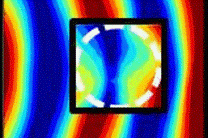Scientists create first free-standing 3-D cloak

Researchers in the US have, for the first time, cloaked a three-dimensional object standing in free space, bringing the much-talked-about invisibility cloak one step closer to reality.
Whilst previous studies have either been theoretical in nature or limited to the cloaking of two-dimensional objects, this study shows how ordinary objects can be cloaked in their natural environment in all directions and from all of an observer's positions.
Published today, 26 January, in the New Journal of Physics, the researchers used a method known as "plasmonic cloaking" to hide an 18-centimetre cylindrical tube from microwaves.
Some of the most recent breakthroughs in the field of invisibility cloaking have focussed on using transformation-based metamaterials — inhomogeneous, man-made materials that have the ability to bend light around objects — however, this new approach uses a different type of artificial material — plasmonic metamaterials.
When light strikes an object, it rebounds off its surface towards another direction, just like throwing a tennis ball against a wall. The reason we see objects is because light rays bounce off materials towards our eyes and our eyes are able to process the information.
Due to their unique properties, plasmonic metamaterials have the opposite scattering effect to everyday materials.
"When the scattered fields from the cloak and the object interfere, they cancel each other out and the overall effect is transparency and invisibility at all angles of observation.
"One of the advantages of the plasmonic cloaking technique is its robustness and moderately broad bandwidth of operation, superior to conventional cloaks based on transformation metamaterials. This made our experiment more robust to possible imperfections, which is particularly important when cloaking a 3D object in free-space," said study co-author Professor Andrea Alu.
In this instance, the cylindrical tube was cloaked with a shell of plasmonic metamaterial to make it appear invisible. The system was tested by directing microwaves towards the cloaked cylinder and mapping the resulting scattering both around the object and in the far-field. The cloak showed optimal functionality when the microwaves were at a frequency of 3.1 gigahertz and over a moderately broad bandwidth.
The researchers, from the University of Texas at Austin, have shown in previous studies that the shape of the object is irrelevant; oddly shaped and asymmetric objects can both be cloaked using this technique.
Moving forward, one of the key challenges for the researchers will be to demonstrate the cloaking of a 3D object using visible light.
"In principle, this technique could be used to cloak light; in fact, some plasmonic materials are naturally available at optical frequencies. However, the size of the objects that can be efficiently cloaked with this method scales with the wavelength of operation, so when applied to optical frequencies we may be able to efficiently stop the scattering of micrometre-sized objects.
"Still, cloaking small objects may be exciting for a variety of applications. For instance, we are currently investigating the application of these concepts to cloak a microscope tip at optical frequencies. This may greatly benefit biomedical and optical near-field measurements," continued Professor Alu.
More information: The published version of the paper "Experimental verification of 3D plasmonic cloaking in free-space" Rainwater D et al 2012 New J. Phys. 14 013054 is freely available at iopscience.iop.org/1367-2630/14/1/013054
Provided by Institute of Physics

















